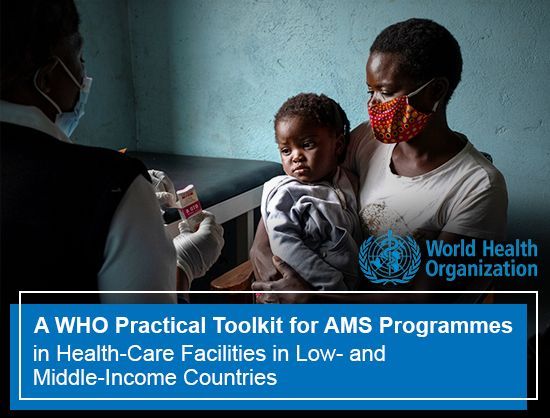
The toolkit provides guidance on where to get started, including the structures and resources that should be put in place at the national and health-care facility level, through a stepwise approach in low-resource settings. As the ultimate goal of an AMS programme is sustainable behaviour change in physicians’ antibiotic prescribing practices, the toolkit also provides detailed guidance on how to plan, perform and assess AMS interventions – including feedback on antibiotic use over time. Finally, the toolkit provides an overview of the competencies an AMS team needs to guide health-care professionals in changing their antibiotic prescribing behaviours.
Please note that this course is part of a training package, so please register for the complementary course WHO Policy Guidance on Integrated Antimicrobial Stewardship Activities so that you can complete your learning journey.
Photo Credits: WHO/Blink Media - Gareth Bentley
Language: English
Course information
This course is also available in the following languages:
This practical toolkit for implementing antimicrobial stewardship (AMS) in healthcare facilities is meant to help low- and middle-income countries achieve this goal. It provides practical guidance to support the implementation of Objective 4 of the Global Action Plan on AMR: optimizing the use of antimicrobial medicines.
The course comprises 7 learning modules and 1 guided simulation. Each module is divided into topics and sub-topics to facilitate better learning retention and recall, and to prevent learner fatigue. The topics focus on providing practical guidance in implementing AMS programme within local contexts and explores the Assessment Tools that are available to enable a successful AMS implementation. The Assessment Tool will be explained through guided simulations that enable learners to 'walkthrough' the various sections. The learning modules will be followed by a summary and an objective assessment to gauge the learners' understanding.
What you'll learn
- Identify the fundamentals of antimicrobial stewardship (AMS)
- Analyse the structures for health-care facility AMS programmes
- Develop and plan an AMS programme in a health-care facility
- Perform AMS interventions in a health-care facility
- Assess an AMS programme
- Identify the education and training required to develop key AMS competencies
- Explain how to use the Periodic Health-Care Facility Assessment Tool
Course contents
Module 1: Introduction to Antimicrobial Stewardship:
By the end of this module, you should be able to: describe how the toolkit helps optimise the use of antimicrobial medicines; define how antimicrobial stewardship forms an integral component of health systems; explain briefly the step-by-step guide on setting up, implementing and monitoring health-care facility AMS programmes.Module 2: Structures for health-care facility AMS programme:
By the end of this module, you should be able to: identify the contextual challenges at the health-care facility level; identify and explain the health-care facility core elements and use the health-care facility core elements list.Module 3: Planning an AMS programme in a health-care facility:
By the end of this module, you should be able to: describe the steps in planning an AMS programme in health-care facilities and developing and developing a health-care facility AMS plan; determine what needs to be done and what can be done by conducting a situational or SWOT analysis; identify the responsibility and accountability of the hospital management, and of those who are to coordinate and implement the AMS programme; identify the links between IPC and AMS in delivering quality health care and optimizing antibiotic use; analyze how measuring the quantity and appropriateness of antibiotic prescribing and use can facilitate improvements in targeting and monitoring AMS interventions; explain how the classification of commonly used antibiotics provides a tool to support antibiotic monitoring and AMS activities, with recommendations on when to use the antibiotics in each category; explain the Global Antimicrobial Resistance Surveillance System (GLASS) and the role of microbiologists in an AMS programme.Module 4: Performing AMS interventions in a health-care facility:
By the end of this module, you should be able to: define the various factors that influence the implementation of an AMS programme; identify the factors that affect the implementation of evidence-based AMS interventions; explore some common, very generic areas for improving antibiotic prescribing; illustrate the continuous quality improvement model to provide a systematic approach for involving clinical staff in AMS team efforts to set SMART goals for change; define the steps that maximise the benefits of an AMS programme including appropriate antibiotic treatment and appropriate antibiotic surgical prophylaxis; describe the different types of AMS interventions that have proven successful in improving antibiotic prescribing practices at health-care facilities; explore different methods of audits, selection of infections and selection of antibiotics; identify the areas where IT can benefit AMS interventions.Module 5: Assessing AMS programmes:
By the end of this module, you should be able to: identify the most relevant and feasible metrics for a particular local setting that can help assess the impact of AMS interventions; assess the various indicators that can be used for structural measures/indicators; process measures/indicators; outcome measures/indicators; identify a stepwise approach for applying different indicators when assessing an AMS programme.Module 6: Education and training:
By the end of this module, you should be able to: describe the key AMS competencies in 5 core domains across 3 different levels; identify the steps in developing a training delivery plan, such as identifying a leader, teachers and participants, and making a time plan; and the various learning delivery modes; explore the differences in effectiveness of different training and education delivery methods that are also context specific.Module 7: Periodic Health-Care Facility Assessment Tool:
By the end of this module, you should be able to: illustrate the purpose, intended users and also when/how to conduct the assessment; explain the various sections of the Periodic Health-Care Facility Assessment Tool and how it is used.Module 8: Summary:
By the end of this module, you should be able to: summarize the topics learnt in the course.Module 9: Assessment
Enroll me for this course
Certificate Requirements
- Gain a Record of Achievement by earning at least 80% of the maximum number of points from all graded assignments.
- Gain an Open Badge by completing the course.